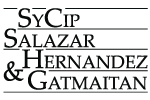The International Comparative Legal Guide to: Copyright 2016
The Philippine section of The International Comparative
Legal Guide to: Copyright 2016 was contributed by SyCipLaw partners Enrique T.
Manuel and Vida M. Panganiban-Alindogan. Mr. Manuel heads the firm’s
Intellectual Property department. The chapter includes information on copyright
subsistence, ownership, exploitation, owners’ rights, copyright enforcement,
criminal offenses, and current developments.
1.1 What are the requirements for copyright to subsist in a work?
Original intellectual creations in the literary and artistic domain are protected under the provisions of the Intellectual Property Code of the Philippines (IP Code).
1.2 On the presumption that copyright can arise in literary, artistic and musical works, are there any other works in which copyright can subsist and are there any works which are excluded from copyright protection?
Apart from literary, artistic and musical works, other works covered by copyright include: architecture; computer programs; and advertisements, maps and technical drawings.
No protection shall however extend, under the IP Code, to: any idea, procedure, system method or operation, concept, principle, discovery or mere data as such, even if they are expressed, explained, illustrated or embodied in a work; news of the day and other miscellaneous facts having the character of mere items of press information; or any official text of a legislative, administrative or legal nature, as well as any official translation thereof.
In addition, no copyright shall subsist in any work of the Government of the Philippines. However, prior approval of the government agency or office wherein the work is created shall be necessary for exploitation of such work for profit. Such agency or office may, among other things, impose as a condition the payment of royalties. No prior approval or conditions shall be required for the use of any purpose of statutes, rules and regulations, and speeches, lectures, sermons, addresses and dissertations, pronounced, read or rendered in courts of justice, before administrative agencies, in deliberative assemblies and in meetings of public character.
1.3 Is there a system for registration of copyright and if so what is the effect of registration?
The IP Code provides for the registration and deposit of copyrighted works with the National Library and the Supreme Court Library. However, in a Memorandum of Agreement signed on January 25, 2011, the National Library deputised the Intellectual Property Office of the Philippines (IPO) as a receiving office for the registration and deposit of copyrighted works. To implement the said deputisation, the Guidelines for Copyright Registration and Deposit was formulated, which includes, among others, a procedure for registration and deposit of copyrighted works with the Intellectual Property Satellite Offices (IPSOs) of the IPO. The said, Guidelines did not however affect the system of deposit of works in the field of law maintained by the Supreme Court Library.
Copyright protection exists from the moment of creation. Works are protected by the sole fact of their creation, irrespective of their mode or form of expression, as well as of their content, quality and purpose. Accordingly, registration is not a mandatory requirement for the protection of a copyrighted work. However, registration establishes a public record of the copyright claim.
1.1 What are the requirements for copyright to subsist in a work?
Original intellectual creations in the literary and artistic domain are protected under the provisions of the Intellectual Property Code of the Philippines (IP Code).
1.2 On the presumption that copyright can arise in literary, artistic and musical works, are there any other works in which copyright can subsist and are there any works which are excluded from copyright protection?
Apart from literary, artistic and musical works, other works covered by copyright include: architecture; computer programs; and advertisements, maps and technical drawings.
No protection shall however extend, under the IP Code, to: any idea, procedure, system method or operation, concept, principle, discovery or mere data as such, even if they are expressed, explained, illustrated or embodied in a work; news of the day and other miscellaneous facts having the character of mere items of press information; or any official text of a legislative, administrative or legal nature, as well as any official translation thereof.
In addition, no copyright shall subsist in any work of the Government of the Philippines. However, prior approval of the government agency or office wherein the work is created shall be necessary for exploitation of such work for profit. Such agency or office may, among other things, impose as a condition the payment of royalties. No prior approval or conditions shall be required for the use of any purpose of statutes, rules and regulations, and speeches, lectures, sermons, addresses and dissertations, pronounced, read or rendered in courts of justice, before administrative agencies, in deliberative assemblies and in meetings of public character.
1.3 Is there a system for registration of copyright and if so what is the effect of registration?
The IP Code provides for the registration and deposit of copyrighted works with the National Library and the Supreme Court Library. However, in a Memorandum of Agreement signed on January 25, 2011, the National Library deputised the Intellectual Property Office of the Philippines (IPO) as a receiving office for the registration and deposit of copyrighted works. To implement the said deputisation, the Guidelines for Copyright Registration and Deposit was formulated, which includes, among others, a procedure for registration and deposit of copyrighted works with the Intellectual Property Satellite Offices (IPSOs) of the IPO. The said, Guidelines did not however affect the system of deposit of works in the field of law maintained by the Supreme Court Library.
Copyright protection exists from the moment of creation. Works are protected by the sole fact of their creation, irrespective of their mode or form of expression, as well as of their content, quality and purpose. Accordingly, registration is not a mandatory requirement for the protection of a copyrighted work. However, registration establishes a public record of the copyright claim.


 Post a comment
Post a comment Print article
Print article

